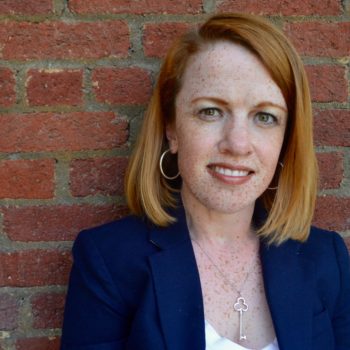Race and disability are inextricably linked. In the United States, 61 million adults, or 26 percent of the adult population, have a disability. Black, Indigenous, and People of Color have a higher incidence of disability with one in four Black Americans and three in ten Indigenous people living with a disability. As we’ve seen during the pandemic, people of color with disabilities have been disproportionately affected by COVID-19 and job loss and are at an increased risk of falling below the poverty line. About 26 percent of people with disabilities people live below the poverty line, with Black and Indigenous individuals with disabilities having the highest rate of poverty, at 36 percent and 34 percent, respectively. Adding gender to the mix, the Center for American Progress found that women with disabilities have a poverty rate of 22.9 percent — double that of women without a disability and five percent more than for men with disabilities.
Knowing this, we as philanthropic organizations can’t address poverty, race, and disability as separate issues. If we attempt a siloed approach, then we are not going to get to the solutions. Understanding the intertwined nature of these disparities and applying disability-explicit and race-explicit lenses are critical to achieving racial equity and economic inclusion. As we seek opportunities to close the racial wealth gap, we must take disability into account.![]()
What’s Missing When We Leave Disability Out of the Conversation
If we overlook disability in our work, then we are overlooking the outdated, discriminatory policies and systems that prevent us from achieving economic justice. The Americans with Disabilities Act and our other laws recognize that people with disabilities have a fundamental civil right to participate fully in our society, yet our system of benefits that provide life-supporting services has asset limits. How can we talk about economic opportunity but ignore the fact that this system penalizes people with disabilities by forcing them to make a choice between an opportunity to earn competitive wages or the ability to access the support and services that they need to live in their communities? In that case, we are not actually addressing poverty. And it is both ableist language and ableist policy when people talk about “ladders” of economic opportunity and mobility. They ignore the fact that those ladders do not actually extend to people with disabilities.
Let’s take housing as another example of the gaps in equity for disabled people. Home ownership is widely understood as a key to wealth building, and we are facing a growing eviction crisis. If we were to omit disability from the conversation about solutions to these issues, it would be like trying to address geographic segregation that exists in our cities without examining the history of redlining, the patterns of investment by banks, and the ways in which the industry either deliberately or through implicit bias reinforces who gets to live where and what communities get the most benefits.
If we are not discussing disability and using a disability-explicit lens when we’re talking about housing, then that means we do not know how many Black and brown people are homeless because of a lack of access to affordable housing that is also accessible. If we’re not talking about disability when we’re talking about the housing crisis, then we don’t know how many Black and brown people are unable to save sufficient funds to purchase a home because they’re struggling to access affordable care to pay for their expenses like prescriptions and personal attendants, or purchasing and maintaining the equipment that they need. If we’re not using a disability-explicit lens, then we don’t know how many Black and brown people don’t have jobs in their communities because they don’t have access to accessible public transportation that will include them and make sure they can get from their homes to their jobs.
So, if we’re not explicitly bringing a disability lens to the conversation, then we are risking developing solutions without seeing the whole picture of the problem that we’re trying to solve. All of us in philanthropy know from our work and our history what happens when policies are developed without addressing the root causes. At best, we get unintended consequences. And at worst, we end up reproducing harm and looking at more devastation in the communities that we’re trying to serve.
Philanthropy’s Role in Advocating for Disability Inclusion
Foundations working on achieving racial equity and economic inclusion must center disability in the conversation. The Chicago Community Trust has made closing the racial and ethnic wealth gap its highest organizational priority and recognizes the importance of disability in achieving this goal. With this in mind, we want to share a few of the approaches we are taking to ensure this lens is foundational in our work. These are tools the philanthropic sector can implement, too, as we work together to close the racial and ethnic wealth gap:
Ask key questions as we design our work:
- What are we missing when we ignore disability?
- How is the work that I’m supporting intersecting with disability?
- Are the organizations and the programs we support inclusive of people with disabilities?
- Have we asked our grant recipients to be accountable for information on disability? And if we haven’t, why not?
Strengthen data collection: We must make an investment in data collection that includes disability. Data provides a fuller picture of the issues and disparities and helps lead to solutions.
Elevate community voices: Guided by the core disability rights principle of “nothing about us without us,” it is important to engage people with disabilities in shaping our work.
Make the financial commitment: Recognize that equity requires taking disability into account and invest in connecting economic justice advocacy work to disability-led organizations to make their strategies truly comprehensive and equitable.
Advance policies: To advance policies that will build and retain wealth for all people, we must examine the policies and funding streams that create inequity for people with disabilities including but not limited to sub-minimum wage for disabled workers, marriage inequality, home and community-based services, and means testing for Medicaid and SSDI benefits.
Closing the racial and ethnic wealth gap is an imperative for the 21st century. We can only succeed if we add a disability-explicit lens to our strategies and investments.![]()
Dr. Helene Gayle is President and CEO of The Chicago Community Trust and a member of the Presidents’ Council on Disability Inclusion in Philanthropy.
Rebecca Cokley is U.S. Disability Rights program officer for the Ford Foundation.





